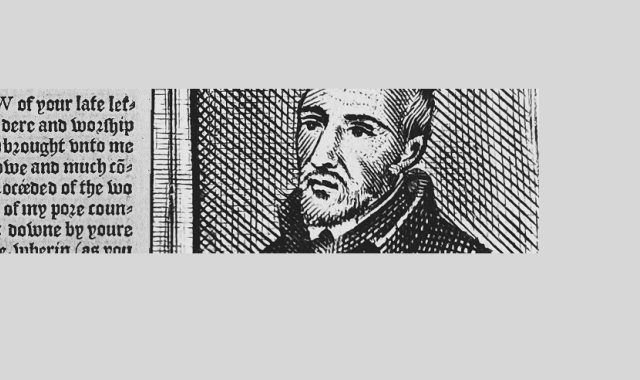Tudor art? Got the t-shirt
- 22 June 2023
- 3 minutes
Returning to David’s Bookshop in Letchworth for a talk on her new book, Gonville & Caius College Fellow Dr Christina Faraday had to improvise when asked about the cover of Tudor Liveliness: Vivid Art in Post-Reformation England.
Christina’s first Saturday job was in the bookshop and following her presentation she was asked a question about the person pictured on the cover. Fortunately she had a convenient prop – and not just the book.
“I was wearing a t-shirt with the book cover printed on it, so I used my t-shirt! It was quite good actually because I hadn’t put the cover boy in my talk,” she says.
“A big part of my argument is that if you just listen to poets, you might think that artists had nothing to offer when it came to representing mental qualities or invisible qualities. According to poets, only poets could access the mind, and painters could only paint the body.
“Actually if you look at Tudor art, there's a whole range of ways that artists found to represent mental state, character, biography and this is a really good example.”
Christina's talk at David's Bookshop in Letchworth, where she used her t-shirt as a prop
Christina points to the impresa in the top left corner, “a device like an emblem that combines image and motto” and the snakes which the man is holding.
She says: “In this case the motto is fata viam invenient (fate will find a way) and the image shows a man standing in a labyrinth.
“He's holding these snakes next to another inscription, fides homini serpentibus fraus which translates to something like faith to man as fraud to serpents.
“His father was what we like to call a hot Protestant. He believed in double predestination: the idea that God has already decided who's going to heaven and who's going to Hell.
“The labyrinth with one path through suggests a belief in fate, and this other expression of the power of faith together show that the siter is fairly confident that he's one of the people going to heaven.”
The identity of the cover star is one of many mysteries which remain in Tudor art, Christina says.
“We don't actually know who he is,” she adds.
“He is a member of the Russell family. He's ‘called’ Edward Russell, but Edward Russell was probably dead when this was painted. So he might be John Russell or another of Edward’s brothers.
“There are so many mysteries in Tudor art still. That's the appeal. You're not even sure of the basics so you have to think more creatively in terms of the rest of the culture and what they might be saying. But I think that's what makes it so exciting.”
Tudor Liveliness is a revision of Christina’s PhD thesis, discussed previously on the College website, where she looked at vividness in Tudor art.
Having taken time away from her thesis, she approached the book differently, presenting the work in a different way, and with new material.
The photos of artefacts in the book illustrate her work. For example, she is simultaneously enamoured and puzzled by some large clay jugs in the shape of people. The size of the objects, which are like a precursor to Toby jugs and which have been called Bartmann jugs (a later term) confuse.
“They’re already really hard to lift without any water in it at all,” she adds.
“In the book I think about their quality of liveliness as a kind of personification; people are often compared to clay vessels in the Bible and other religious texts so the metaphor would have been incredibly familiar to Christian audiences and those of other faiths as well. ‘God as the potter’ – there is a kind of literalism in the way this metaphor is embodied by the pots.”
Christina is now writing a book for a general audience about Tudor art and focusing her research on music and art in Elizabethan England.






